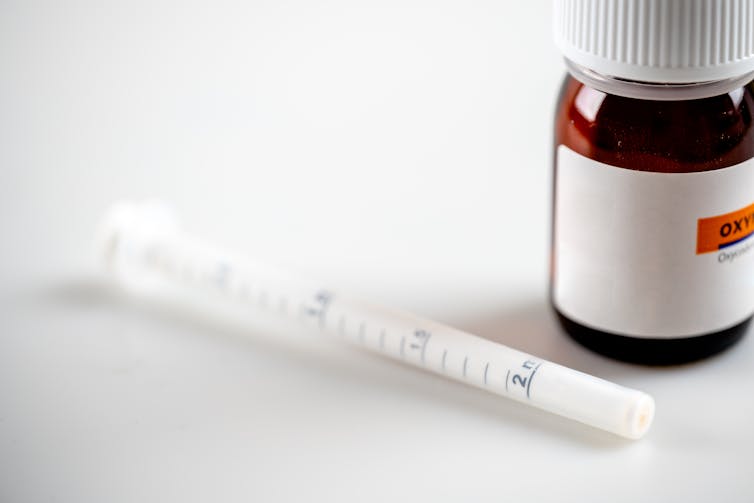
Australia currently finds itself in the unusual position of being both in an opioid epidemic and experiencing a shortage of these critical medicines.
The Therapeutic Goods Administration has placed eight oral morphine products on its shortage list. It doesn’t expect supply for these products to be resolved until around October or November this year.
This is a problem for the near 100,000 people receiving palliative care who may rely on opioids, such as morphine, to manage their daily chronic pain.
So why are we short and what are clinicians and patients doing instead?
Opioids are critical for those in palliative care
Palliative care aims to ensure quality of life for people who have illnesses with little or no chance of being cured. Anyone can need palliative care, including babies, children and teenagers, not just adults and elderly people.
Patients may be in palliative care for days, weeks or even months and they usually experience daily chronic pain. Opioid medicines, such as morphine, are commonly used to relieve their pain, distress and discomfort.

Morphine is a strong pain-relieving medicine often used once other medicines, like ibuprofen and paracetamol, are no longer effective. It works to block the pathways in the brain that register pain sensation.
Morphine can be taken as a tablet, capsule or oral liquid, as an injection, or via a pump the patient controls. The eight morphine products Australia has placed on the short list are all oral forms (tablets and liquids).
Oral liquid forms of morphine are an important formulation for those who may not be able to use tablets, including young children or elderly patients and people who have trouble swallowing.
Why are we having shortages of these medicines?
Since COVID, we have seen rolling shortages of many medicines, due to supply chain disruptions and other issues. There are currently 377 medicines on the Therapeutic Goods Administration’s shortages list. But the shortage of morphine medicines do not appear to be due to COVID.
In June last year the international company Mundipharma, which produced the only registered brand of liquid morphine used in Australia, Ordine, advised the government it was discontinuing supply. An Australian company, Arrotex Pharmaceuticals, is scheduled to take over. However, supply is not expected to return to normal until their products become available – likely in late 2024.
While the current shortage is for oral morphine, other opioids are going out of stock as well, such as fentanyl (six products on the short list) and oxycodone (three products). This is because when there is a shortage of one medicine, like morphine, it pushes up the demand for similar medicines.
Can you substitute one opioid for another?
There are lots of different types of opioid medications, meaning when one is not available a patient may be switched to another. Which drug is substituted – and in what dosage – is important.
Because of the way opioids are metabolised by the body, the dose of one drug may have work more or less effectively when compared with the same dose of a different opioid. In these cases, the pharmacist needs to calculate what is called the “equivalent analgesic dose” when switching opioids.
In addition to calculating the equivalent dose, when changing to a different opioid, the doctor may also reduce the dose by 50%. This is because stronger opioid medicines, like fentanyl, are very risky in higher concentrations, and have a higher chance of leading to breathing difficulties and even death.

Adjusting the dose according to the way the drug is administered is also important. For example, the dose needed when morphine is injected is usually much lower than when it is taken by mouth as a tablet or liquid.
What’s being done about this shortage and where to from here?
The Australian government has approved three overseas substitute products to fill the gap until supply returns to normal. These are being sponsored by the Australian company Medsurge Healthcare and include two liquid formulations of morphine sulfate and one liquid formulation of morphine chloride. Both work the same way and are just as effective for pain.
Where patients still aren’t able to access opioid medicines within the Australian healthcare system, there are reports some are paying up to $4,000 to source their own supply from overseas.
But these are stop-gap measures, similar to the solutions being employed for the current IV fluids shortage, and is just another example of why the Australia government needs to invest in local manufacturing of medicines.
If you, or a person close to you, needs palliative care pain relief, there are still many options. Talk to your healthcare provider to work out the best approaches to ensure you, or your loved one, are free of pain.
Nial Wheate in the past has received funding from the ACT Cancer Council, Tenovus Scotland, Medical Research Scotland, Scottish Crucible, and the Scottish Universities Life Sciences Alliance. He is a fellow of the Royal Australian Chemical Institute, a member of the Australasian Pharmaceutical Science Association and a member of the Australian Institute of Company Directors. Nial is the chief scientific officer of Vaihea Skincare LLC, a director of SetDose Pty Ltd (a medical device company) and was previously a Standards Australia panel member for sunscreen agents. Nial regularly consults to industry on issues to do with medicine risk assessments, manufacturing, design, and testing.
Associate Professor Tina Hinton has previously received funding from the Schizophrenia Research Institute (formerly Neuroscience Institute of Schizophrenia and Allied Disorders). She is currently a Board member of the Australasian Society of Clinical and Experimental Pharmacologists and Toxicologists.
This article was originally published on The Conversation. Read the original article.






